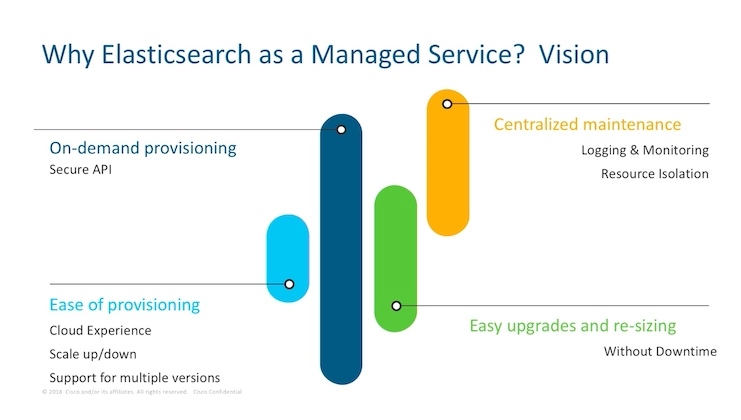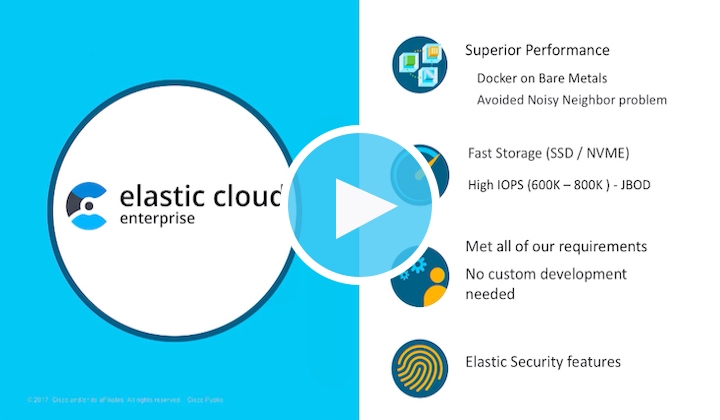Elastic Cloud Enterprise at Cisco
This post is a recap of a community talk given at a recent Elastic{ON} Tour event. Interested in seeing more talks like this? Check out the conference archive or find out when the Elastic{ON} Tour is coming to a city near you.
Networking and tech giant Cisco Systems, much like any large organization, produces an enormous amount of data and content internally. And figuring out efficient and practical ways to share all that information across their tens of thousands of employees — and their extensive network of sellers and partners — all over the world is an obvious challenge. “Cisco teams used different technologies for enterprise search. The experience was fragmented and information findability was a real problem. There was no one way to find info across the enterprise. Relevancy was bad, and federated search never worked,” said Sujith Joseph, a Cisco Enterprise Search Architect.
Cisco had been using Elasticsearch, but not in a uniform fashion across teams. Enterprise search was a glaring problem: Users had trouble finding relevant content, which was siloed off by department. Some teams were duplicating operations work done by other teams, which complicated matters further. Additionally, Cisco lacked an overall Elastic skillset — a team to lean on to create optimal configurations and to support such a large system. And critically, they also lacked the ability to centrally manage and monitor their growing number of clusters.
Joseph and a team of his IT colleagues were tasked with developing an easier to use, easier to manage, more relevant, and more effective search experience for finding important information across the enterprise. Cisco wanted to move all their varied Elasticsearch efforts into a single managed service. They chose Elastic Cloud Enterprise (ECE), which checked all the boxes for their internal requirements:
- Simple upgrades and resizing — Ease of upgrade and cluster resizing, all without downtime
- On-demand, secure cluster provisioning — Ability to provision clusters via API in a secure manner
- Ease of provisioning — A cloud-like experience, one that could easily scale up and down, and offered support for running multiple versions of Elasticsearch at the same time
- Centralized maintenance — An easy-to-use console for Elasticsearch management, such as logging, monitoring, and resource isolation
- No custom development needed — “It just worked out of the box,” said Joseph.

Cisco’s use of ECE in IT and other departments continued to grow quickly. They index about 3 billion documents per day, across 24 clusters and 270 nodes. Cisco describes the business value and benefits of ECE as increased innovation and agility, faster realization of business goals, and greater operational efficiency.
“Just like Elasticsearch is popular out there, it is also popular within Cisco, especially in Cisco IT.”
So just how does Cisco use ECE? It’s used broadly throughout the company, and a handful of those uses were highlighted in their Elastic{ON} presentation. These solutions have dramatically improved Cisco’s enterprise search issues, and they’re thrilled with the way they can oversee the entire operation so easily with ECE’s management and monitoring tools.
The recommendation engine in Cisco SalesConnect app — the second-most-used tool by Cisco sellers — is helmed by ECE. It’s used by Cisco sellers and partners to find the collateral, demos, training, and proposals they need to close more business. It also offers personalized recommendations on products, solutions, services, training, partner programs, and many more for all sales- and partner-focused content. It takes the user’s job role and a specified topic of interest to offer up relevant recommendations. Analytics and index information from Cisco’s 18,000 sellers and thousands of partners gets merged together in Apache Spark and indexed via Logstash. All user clicks are tracked by Logstash and sent to Elasticsearch periodically so that recommendations can change dynamically. Then all the analyzed user data is visualized through Kibana.
ECE also drives Cisco’s sales compensation reporting system, which Cisco sellers describe as their single most critical tool. All the bookings data resides in an Oracle database, but the legacy app they used previously for reporting had response times that were far too slow — around 30 seconds. After switching to ECE, Cisco began denormalizing all the Oracle data into Apache Spark and indexing it into Hive before finally making its way into Elasticsearch. With the new system, Cisco was able to reduce report generation times from 30 seconds down to less than 1 second.
Want to hear more about the technical nitty gritty — including configuration details and infrastructure specs — behind Cisco’s Elastic Cloud Enterprise implementation? Or maybe hear about other interesting ways that Cisco uses Elasticsearch, such as partnering with Google, MIT, and others to help the U.S. Patent and Trademark Office in the fight against technology patent trolls? Or learn more about how Cisco uses machine learning and Elasticsearch to improve Cisco.com search query understanding and prediction? Watch the full Cisco presentation at Elastic{ON} Santa Clara.
If you want to provision, manage, and monitor Elasticsearch and Kibana at any scale, take a closer look at Elastic Cloud Enterprise, or get some expert tips for migrating to ECE. Interested in a ready-made, easy-to-implement enterprise search solution instead? Elastic Enterprise Search may be right for you.
